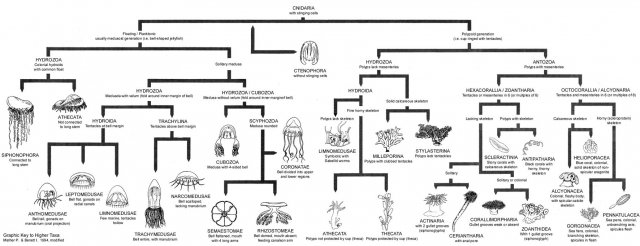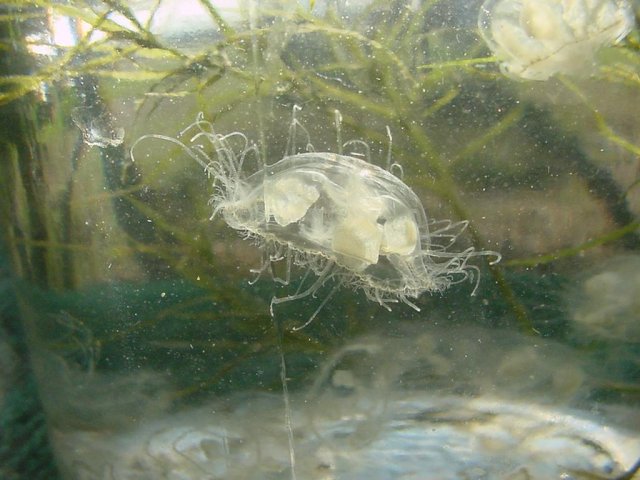Let's start off with some of their basic taxonomy, here is a little key below: and then an image of the jellyfish.
and then an image of the jellyfish.  Kingdom: Animalia Phylum: Cnidaria
Kingdom: Animalia Phylum: Cnidaria
Class: Hydrozoa Order: Limnomedusae
Family: Olindiidae
Genus: Craspedacusta
Species: Sowerbii
G E O G R A P H I C R A N G E:
Endemic to every continent except the arctics, it has been found in every state of the USA except for Alaska, Montana, South Dakota, North Dakota, Wyoming, and Hawaii and has also been found in every province of Canada except for Alberta and Saskatchewan. They are generally found in still, usually a little stagnant waters, but are also found in gently flowing rivers and streams, such examples in the USA would be the Allegheny river, Tennessee river, and Ohio river. They are also native to the yangtze (pronounced yont - see) river basin in China as well as the Wang Thong river in thailand. Recent sightings have been reported to have been in the Cauvery/Kaveri rivers and the Hemavathi river backwaters of India, but Brazil as well as Argentina.
A N A T O M Y:
They are give or take a little an inch, and have 400 tentacles MAX around clustered around the bell margin. Hanging from the inner bell is the manubrium, made up of four frilly lips. The nutrients are circulated by the four radial canals which originate at the stomach and continuing to a ring canal attached to the bell margin. The body usually has a green/white tinge and is transparent/translucent. They are most commonly found with four flat opaque white gonads attached to the bell margin. The hundreds upon hundreds of tentacles each contain thousands upon thousands of cnidocytes, which in turn contain cnidocysts, used to pass prey up to the mouth, which poops out of the same opening, haha. The bell margin is made up of statocysts, and the velum, cnidocysts, which are useful in passing up prey to the mouth. A lesser known fact is that these jellyfish have "eye spots" which can sense different levels of light which aid in avoiding prey. Locomotion is executed by contracting its bell surface which take it in the direction it pleases if there isn't much current in the water. Stings haven't been recorded to be of any danger to humans as of yet, because the small cnidocysts cannot penetrate our skin, and are only used for paralyzing their tiny prey and their smaller, if any, predators. The venom contents has not been recorded as of yet.
R E P R O D U C T I O N: these jellies reproduce asexually and make polyps by budding. The buds have three different ways to go, either polyps, medusa, or frustule buds. The frustule bud develops into a frustule, obviously, a polyp develops and grows while attached to the original polyp, and the medusa bud, sadly, doesn't get a childhood and becomes a free swimming already sexually mature adult which produces fertilized eggs that develop into planula larvae. The planula fall and attach to more stationary objects and grow into a polyp. Sexual reproduction has been documented very little as the vast majority of the populations are either all male, or all female. In winter, the polyps usually turn into a form of polyp called a podocyst, which is used for surviving the seasons, until it gets back to more desirable temperatures.
F E E D I N G: food mainly consists of the usual 1mm. long zoo plankton, but they also feed on daphnia, freshwater copepods, scuds, etc. Wow that was short, moving on!
C O N S E R V A T I O N:
Listed by the IUCN as.......... Well, they aren't even listed! Not much conservation is at work to save them because nobody knows what will be there the next year! Populations will be extreme until it seems like there are jellies everywhere in a single body of water, but as of next year, they could be gone. Until there could be a giant bloom of them again 7 years later. Nobody can control them, so nobody knows what will happen the next year causing rather large shifts in the microfauna of that area.
A Q U A R I U M C A R E:
No special conditions, as long as there is no corners or objects for them to get stuck on, including sponge filters hanging down from the tank and sharp corners. Kreisels with a circular flow will actually NOT be needed because these jellies can already swim, similar to Cassiopeia a saltwater jellyfish that is upside down. Cassiopeia isn't an ordinary jelly anyway so why am I using it to compare? Cassiopeia also isn't even a jellyfish in the first place, its a genus of 8 species. Besides the point, I'm getting off topic. Feed daphnia, scuds, brine shrimp etc. but just remember these aren't a very long lasting pet. The medusa that is so pretty is only a temporary form!
W H E N T H E Y W E R E F O U N D: First reported all the way back in 1880 in england as a new species, found in the USA in 1908, and by 2000 they were reported to have been officially found in 43 states. Nowhere is ever going to be known for their freshwater jellies as the constant spread of these continue.
A F T E R W O R D : in my opinion these are another one of gods amazing creatures that show how amazing the life is around us. Documentation has been very successful in this species and I hope many more discoveries are revealed.
Hope you liked the guide!
Jackson,
 and then an image of the jellyfish.
and then an image of the jellyfish.  Kingdom: Animalia Phylum: Cnidaria
Kingdom: Animalia Phylum: Cnidaria Class: Hydrozoa Order: Limnomedusae
Family: Olindiidae
Genus: Craspedacusta
Species: Sowerbii
G E O G R A P H I C R A N G E:
Endemic to every continent except the arctics, it has been found in every state of the USA except for Alaska, Montana, South Dakota, North Dakota, Wyoming, and Hawaii and has also been found in every province of Canada except for Alberta and Saskatchewan. They are generally found in still, usually a little stagnant waters, but are also found in gently flowing rivers and streams, such examples in the USA would be the Allegheny river, Tennessee river, and Ohio river. They are also native to the yangtze (pronounced yont - see) river basin in China as well as the Wang Thong river in thailand. Recent sightings have been reported to have been in the Cauvery/Kaveri rivers and the Hemavathi river backwaters of India, but Brazil as well as Argentina.
A N A T O M Y:
They are give or take a little an inch, and have 400 tentacles MAX around clustered around the bell margin. Hanging from the inner bell is the manubrium, made up of four frilly lips. The nutrients are circulated by the four radial canals which originate at the stomach and continuing to a ring canal attached to the bell margin. The body usually has a green/white tinge and is transparent/translucent. They are most commonly found with four flat opaque white gonads attached to the bell margin. The hundreds upon hundreds of tentacles each contain thousands upon thousands of cnidocytes, which in turn contain cnidocysts, used to pass prey up to the mouth, which poops out of the same opening, haha. The bell margin is made up of statocysts, and the velum, cnidocysts, which are useful in passing up prey to the mouth. A lesser known fact is that these jellyfish have "eye spots" which can sense different levels of light which aid in avoiding prey. Locomotion is executed by contracting its bell surface which take it in the direction it pleases if there isn't much current in the water. Stings haven't been recorded to be of any danger to humans as of yet, because the small cnidocysts cannot penetrate our skin, and are only used for paralyzing their tiny prey and their smaller, if any, predators. The venom contents has not been recorded as of yet.
R E P R O D U C T I O N: these jellies reproduce asexually and make polyps by budding. The buds have three different ways to go, either polyps, medusa, or frustule buds. The frustule bud develops into a frustule, obviously, a polyp develops and grows while attached to the original polyp, and the medusa bud, sadly, doesn't get a childhood and becomes a free swimming already sexually mature adult which produces fertilized eggs that develop into planula larvae. The planula fall and attach to more stationary objects and grow into a polyp. Sexual reproduction has been documented very little as the vast majority of the populations are either all male, or all female. In winter, the polyps usually turn into a form of polyp called a podocyst, which is used for surviving the seasons, until it gets back to more desirable temperatures.
F E E D I N G: food mainly consists of the usual 1mm. long zoo plankton, but they also feed on daphnia, freshwater copepods, scuds, etc. Wow that was short, moving on!
C O N S E R V A T I O N:
Listed by the IUCN as.......... Well, they aren't even listed! Not much conservation is at work to save them because nobody knows what will be there the next year! Populations will be extreme until it seems like there are jellies everywhere in a single body of water, but as of next year, they could be gone. Until there could be a giant bloom of them again 7 years later. Nobody can control them, so nobody knows what will happen the next year causing rather large shifts in the microfauna of that area.
A Q U A R I U M C A R E:
No special conditions, as long as there is no corners or objects for them to get stuck on, including sponge filters hanging down from the tank and sharp corners. Kreisels with a circular flow will actually NOT be needed because these jellies can already swim, similar to Cassiopeia a saltwater jellyfish that is upside down. Cassiopeia isn't an ordinary jelly anyway so why am I using it to compare? Cassiopeia also isn't even a jellyfish in the first place, its a genus of 8 species. Besides the point, I'm getting off topic. Feed daphnia, scuds, brine shrimp etc. but just remember these aren't a very long lasting pet. The medusa that is so pretty is only a temporary form!
W H E N T H E Y W E R E F O U N D: First reported all the way back in 1880 in england as a new species, found in the USA in 1908, and by 2000 they were reported to have been officially found in 43 states. Nowhere is ever going to be known for their freshwater jellies as the constant spread of these continue.
A F T E R W O R D : in my opinion these are another one of gods amazing creatures that show how amazing the life is around us. Documentation has been very successful in this species and I hope many more discoveries are revealed.
Hope you liked the guide!
Jackson,





